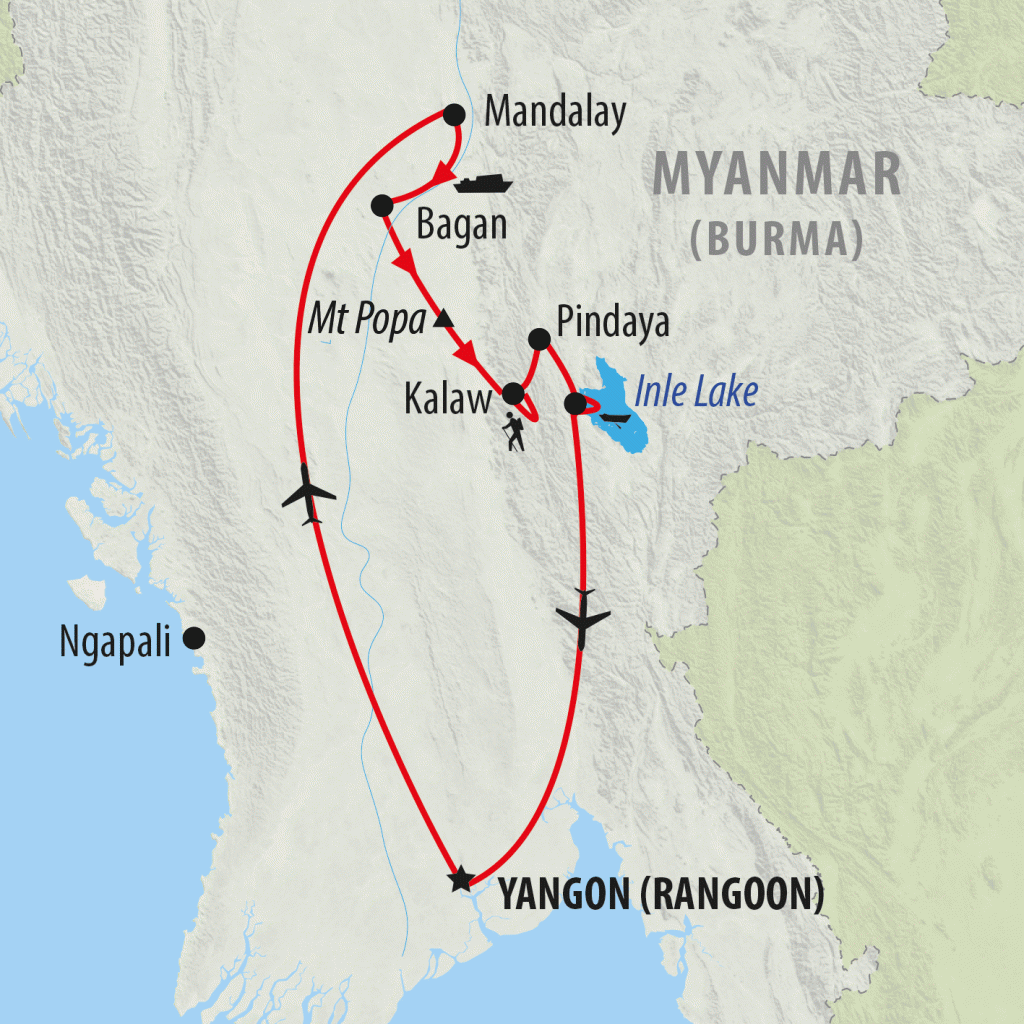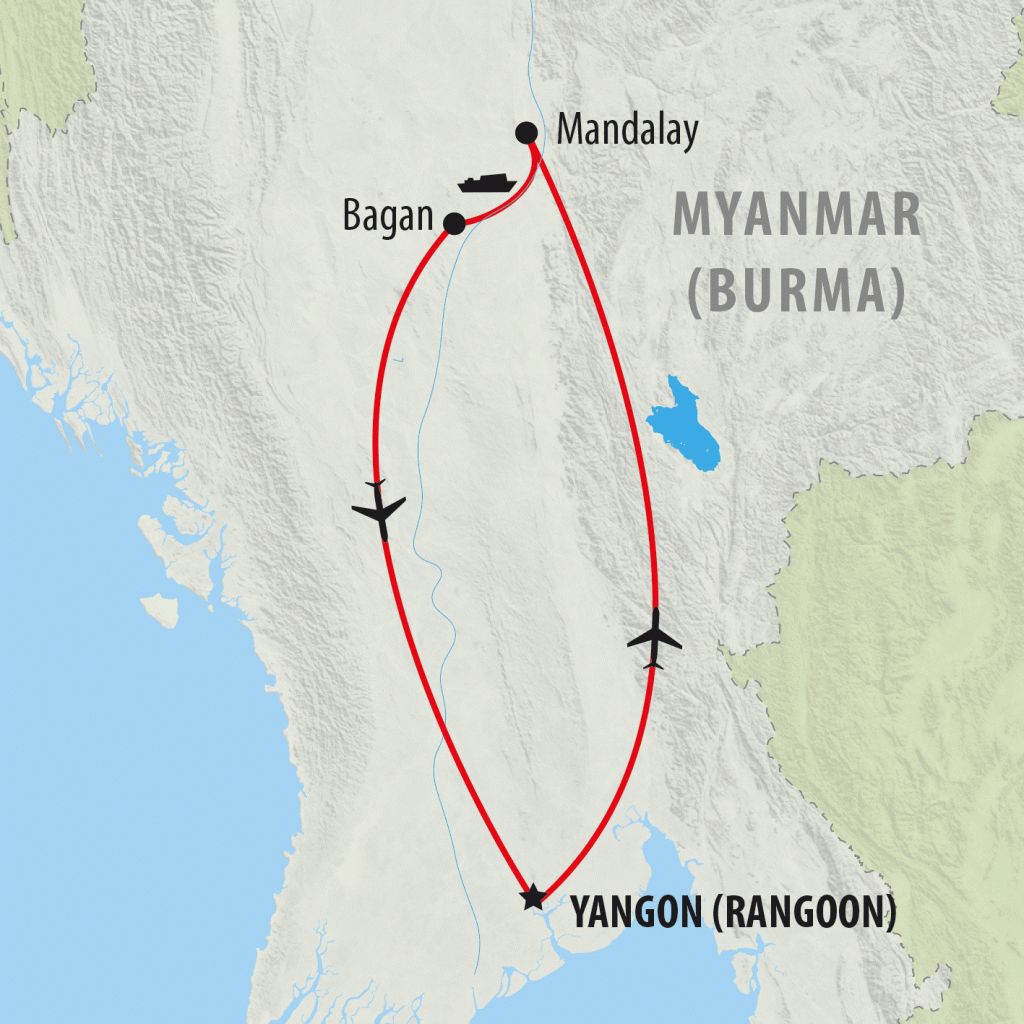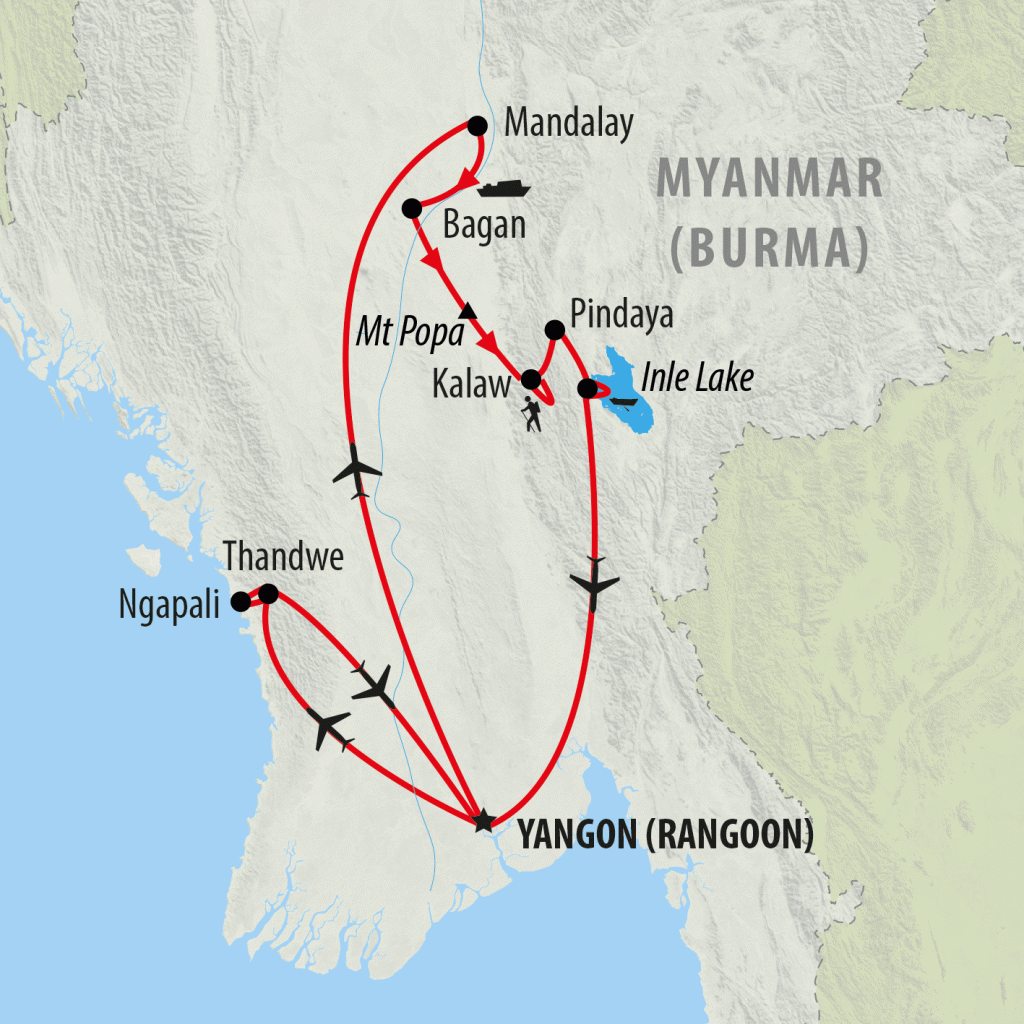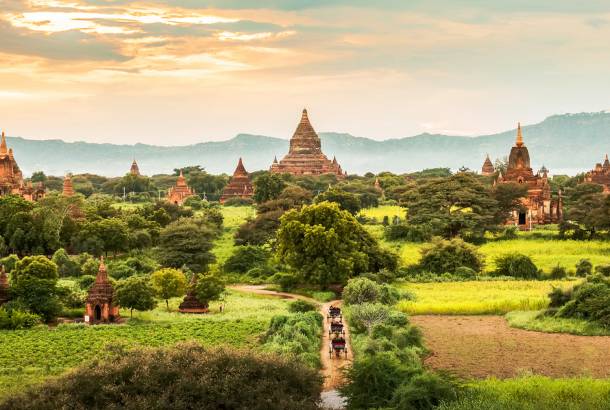
Start planning your trip to Myanmar with our handy travel tips that cover everything from health to currency, shopping to WiFi. Want to know whether you should tip at restaurants? Or where you can find ATMs? Or how about what plug sockets you'll encounter? We've got the answers right here.
What vaccinations do I need for Myanmar?
You should seek medical advice from your local health practitioner before travelling to Myanmar and ensure that you receive all of the appropriate vaccinations. As a guide Diphtheria, Hepatitis A, Typhoid, Polio and Tetanus are strongly recommended.
Do I need anti-malaria tablets for Myanmar?
There is a risk of malaria in rural areas throughout the country with altitudes of 1,000m or less, however, there is none in the cities of Mandalay and Yangon. The estimated relative risk of malaria for travellers is moderate and so malaria tablets should be taken as a precaution. It is also important to avoid mosquito bites as much as possible. This can be achieved by wearing long sleeves and trousers, sleeping under a mosquito net and wearing an insect repellent that contains at least 50% DEET. For more information on the malaria risk in Burma visit the NHS Fit to Travel page or the CDC Traveler's Health page.Is it safe to drink tap water in Myanmar?
As tap water is not safe to drink in Myanmar, only drink bottled mineral water, which is readily available in hotels, shops and restaurants, or water that has been purified. You should also avoid salads which may be washed in unhygienic water and ice as it might have been made with tap water.
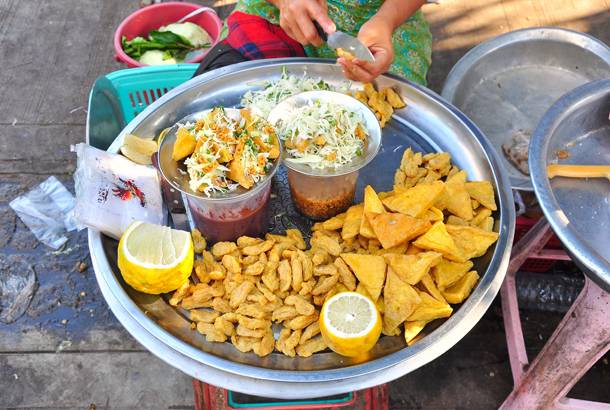
What's the food like in Myanmar?
The traditional breakfast is varied, composed of fried rice and peas, nan pya (Indian bread) and cream or goat-leg soup, monhingar, nangyi, coconut noodles, assorted fried vegetables, steamed glutinous rice and peas, traditional snacks or bread and butter. It is usually washed down with Chinese or strong green Burmese coffee or tea.
A typical lunch or dinner consists of a main dish, a side dish, a sweet or sour soup and a form of fish paste or shrimp paste. The main dish typically features pork, chicken, mutton, beef, fish, shrimp, duck, eggs, or catfish, that’s cooked, stewed, fried, steamed, roasted, broiled, boiled or simmered in various ways. Ngapi, which means pressed fish, is a speciality present at most meals. Another common dish is balachaung, a fried shrimp paste with crushed garlic, onions and chillies. Side dishes are usually a salad made with vegetables combined with meat, fish or shrimp. Soups are either sweet or sour and mostly vegetables with meat or fish. A popular finish to a meal is the betel chew. The dried areca nut is wrapped in the betel leaf with a lime paste. Sometimes tobacco, peppermint or other spices are added. For dessert try, Shwe Kyi, a rich semolina pudding or Kyauk Kyaw - a seaweed jelly with a layer of coconut milk layer on top.
Traditional ethnic specialities include the Khauk-Swe that is composed of wheat noodles in a broth made with chili-marinated chicken; it is typical of Shan cuisine. Other Shan dishes are ttamin chin, a rice salad made with turmeric and khauk sen, rice noodles with fish. The Mon food usually contains chillies and curry. The Rakhines cuisines enjoy spicy curries and seafood is popular. Talapo is a Karen dish made of rice and bamboo shoots, lemon grass and fish paste that is certainly worth a try.
Ethnic dishes such as Chinese and Indian foods are popular as well, but these can only be found in the larger cities and towns. Burmese are lovers of snacks and you'll find plenty of street stalls selling these towards the evening.
Fresh lemon/lime juice mixed with water is one of the most refreshing drinks in the tropics as is tea. Chinese tea is generally preferable to the over-strong, over-sweet and over-milky Burmese tea. Sugar-cane juice is a popular street-side drink and stronger refreshments include orange brandy, lychee wine, white liquor or the local jungle liquor, fruit juice, water-buffalo milk and Mandalay beer.
Safe eating while travelling in Myanmar
Still a country in the process of developing, food hygiene in Myanmar is not great. Due to the undrinkable tap water and lack of education regarding safe sanitation, there is a greater risk of encountering food problems than other areas of the world. In order to eat as safely as possible, travellers should avoid anything that could have come into contact with tap water (salad, ice, unpeeled fruit, raw vegetables) and stick to pasteurised dairy products. Hot food should only be eaten if it is piping hot and street food should be avoided if it looks old or like it has been sitting in the sun for too long. Common sense is key when it comes to eating in Myanmar – if your food doesn’t look or smell right, don’t take the risk.Is it standard to tip in Myanmar?
Tipping is not expected in Burmese culture but is greatly appreciated by workers as even a tip of a dollar will be a big supplement to their wages. Leaving 10% or so on top of your bill in a restaurant and rounding up a taxi fare are generous gestures and will certainly leave you on good terms with whoever has served you. A dollar per day for hotel staff is an appropriate amount if the service has been up to standard. If you don’t have cash on you, cosmetics, toiletries, western clothing and music will all be happily received by Burmese people.
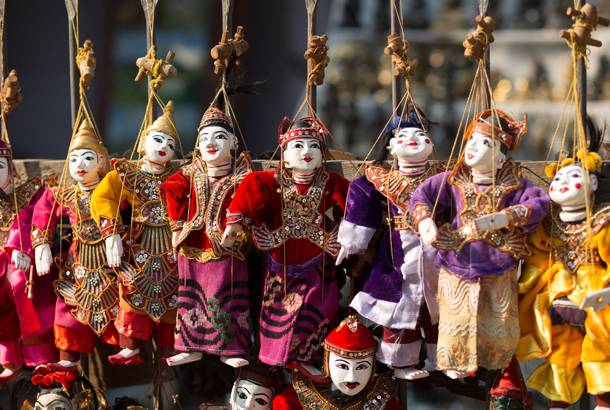
What is good to shop for in Myanmar?
Myanmar offers a grand assortment of gifts and souvenirs, most of which are handmade and specific to a particular geographic region. Among local souvenirs, Pan Yoon (Lacquerware) is the most admired. Lacquerware is made from bamboo, wood and thick black varnish and often depicts scenes of the landscape and local life. Lacquerware from central region i.e. Mandalay and Bagan possesses legendary drawing styles, which date back to the 11th century. Craftsmen pay such tremendous attention to each and every detail that they sometimes claim their products were not crafted with hands, but with their hearts.
Gems and jewellery can be found everywhere in Myanmar with rubies, diamonds, cat’s eyes, emeralds, topaz, jades and pearls earning a solid reputation on the world market. Burmese puppets are also popular purchases and with elaborate costumes. They are used in the old, epic puppet performances and are beautifully crafted in the Burmese style with gilt, sequins and glass jewels. Hand-woven silks and fabrics also make excellent souvenirs.
How to bargain in Myanmar
While haggling is not unheard of in Myanmar, it is certainly much less common than it is in other Southeast Asian countries and can be a much more delicate procedure. In Myanmar, respect and not losing face are incredibly important so offering a ridiculously low price is a big no-no. Generally, prices won’t be too expensive and a country like Myanmar could really do with the extra dollars they have tacked on to the price of your purchase. Unless you feel like you are being extortionately ripped off, it is better to leave the haggling for another day.Is it safe for a single woman to travel in Myanmar?
Women don’t usually encounter problems in Myanmar. As a deeply Buddhist country, women are respected from a distance but are still excluded from certain things, such as touching the golden rock and the monks. Nevertheless, most monks will happily engage in conversation with women, as will most other civilians. Short skirts and revealing clothing might attract some unwanted attention, both lustful and quietly disgusted, so blending in by wearing conservative clothing is recommended.
What's the etiquette when visiting temples in Myanmar?
Like most of Southeast Asia, Myanmar is filled with exquisite Buddhist temples, which have customs and rules that should be respected by all visitors. Dress appropriately (long sleeves and trousers) and be sure to remove any headwear and shoes before entering a temple. Once inside, under no circumstances should you touch or turn your back on a Buddha statue. The Burmese have very strict laws about disrespecting the image of Buddha and those found breaking the rules can be sentenced to up to four years in prison.
Is Myanmar a suitable family holiday destination?
Myanmar is far from the typical family holiday destination but it has a lot to offer both adults and children. Vibrant markets will entice people of all ages and the range of physical activities, from hiking to cycling, is excellent for little ones with energy to burn. The country as a whole is still unused to seeing foreigners, let alone those with children in tow, so expect a lot of attention (almost always positive) from locals. Be aware that the health services in Myanmar are significantly inferior to what you are used to at home and getting sick whilst here could be problematic. Eating safely and avoiding mosquito bites will reduce the need for medical care whilst on holiday.
What is the duty free allowance for Myanmar?
Travellers are permitted to take the following into Myanmar:
- 400 cigarettes, 50 cigars or 250g of tobacco
- Two litres of alcoholic drinks
- 150ml of perfume
- Other goods to the value of US$500
Officially, you must declare valuable jewellery - failure to do so may result in you being refused permission to export it on departure.
The following are banned from being imported into Myanmar: Counterfeit currencies and goods, pornography, narcotic drugs and psychotropic substances, playing cards, and goods bearing the image of the national flag, the emblem of Buddha or the pagodas of Myanmar.
What is the currency in Myanmar?
The official currency in Myanmar is the Myanmar Kyat. Check OANDA for the latest exchange rates.
Euro, British Pounds, US Dollars and other major currencies can be exchanged locally at the airport, bureau to changes and banks. However, the official rate is often very different to the market rate and some exchange booths (especially at the airport) offer a very poor rate. We recommend you wait until meeting our representative or your tour guide for advice on the best places to exchange. Alternatively ATMS can be found in all major town and cities, allowing you to withdraw Myanmar Kyat.
If exchanging USD bills they should be of the new series (‘big’ heads rather than ‘small’ heads) and any notes that are old, torn or marked will not be accepted.
It's advisable to request bank notes in smaller denominations, as it can sometimes be hard to get change from large notes and smaller notes are handy for smaller purchases and gratuities. Traveller's Cheques are not recommended as they're often difficult to exchange and incur high fees.

What do things cost in Myanmar?
Generally, Myanmar is on the lower end of the price scale and most travellers will find that a budget of USD $10 per day for food is more than enough, especially if breakfast is included with your hotel room. Accommodation can come to a little more than you might expect as hotel-owners have to purchase an expensive tourist license in order to accommodate foreigners. Nevertheless, a reasonable double room shouldn’t amount to much more than around USD $20-30 per night.
The main tourist sites usually have entrance fees - the most expensive of these is Bagan, which costs around USD $12. Public transport in Myanmar is very good value, with a luxury bus from Yangon to Mandalay coming to less than USD $15 and local buses costing just a few cents per ride.
What sort of plugs do I need for Myanmar and what is the voltage?
Standard voltage is 220 - 240 volts. Primary sockets generally require 2 flat prong plugs, 2 round pin plugs, and 3 fat round pin plugs. We recommend that you pack a universal travel adaptor. Most of the international hotels have their own generators. Other places may experience power cuts and voltage fluctuation so it's best to pack a voltage regulator or stabilizer to protect electrical items.
Is WiFi widely available in Myanmar?
WiFi can be found in Myanmar but it's definitely not a given in any location and is likely to be painfully slow, to the point of being unusable.
What time zone is Myanmar on?
Myanmar is 6 hours 30 minutes ahead of Greenwich Meantime (GMT) and does not observe Daylight Saving.
Travelling during public holidays
The Thingyan Water Festival is the biggest national festival to take place in Myanmar and during this time it can be hard to remain mobile. Train and bus services are either reduced or don’t operate at all and offices close, often for longer than just during the festival. Transport on the days leading up to the start of festival can also be challenging as it can get very busy.
See Also
If you're looking for more information to help plan your visit to Myanmar, check out our handy Travel Guide resources:
Best Places to Visit - what to see and where to go in Myanmar
Tourist Visas - everything you need to know for visa procurement and regulations
Best Time to Visit - climate and seasons in Myanmar










